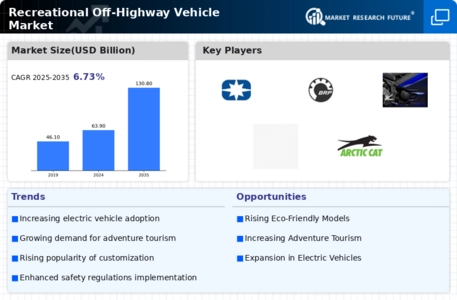Technological Innovations
Technological innovations are reshaping the Recreational Off-Highway Vehicle Market, driving advancements in vehicle performance, safety, and user experience. Manufacturers are increasingly integrating cutting-edge technologies such as GPS navigation, advanced suspension systems, and enhanced fuel efficiency into their vehicles. These innovations not only improve the overall riding experience but also attract a broader consumer base, including younger demographics who value modern features. The Recreational Off-Highway Vehicle Market is witnessing a shift towards more sophisticated models that cater to tech-savvy consumers, potentially leading to increased sales and market expansion. As technology continues to evolve, it is likely that the market will see further enhancements that align with consumer expectations.
Increasing Disposable Income
The rise in disposable income among consumers appears to be a pivotal driver for the Recreational Off-Highway Vehicle Market. As individuals experience enhanced financial stability, they are more inclined to invest in leisure activities, including off-highway vehicle ownership. This trend is particularly evident in regions where economic growth has been robust, leading to a surge in recreational spending. According to recent data, households with higher disposable income are likely to allocate a portion of their budget towards recreational vehicles, thereby stimulating demand in the market. The Recreational Off-Highway Vehicle Market is thus poised to benefit from this economic phenomenon, as more consumers seek outdoor adventures and recreational experiences that these vehicles provide.
Growing Interest in Outdoor Activities
The increasing interest in outdoor activities is significantly influencing the Recreational Off-Highway Vehicle Market. As more individuals seek to escape urban environments and engage with nature, the demand for off-highway vehicles has surged. This trend is supported by data indicating that participation in outdoor recreational activities has risen, with many consumers prioritizing experiences over material possessions. The Recreational Off-Highway Vehicle Market is likely to see continued growth as enthusiasts seek vehicles that enhance their outdoor experiences, whether through trail riding, camping, or exploring remote areas. This shift towards outdoor leisure activities suggests a promising future for the market, as manufacturers respond to evolving consumer preferences.
Rising Popularity of Adventure Tourism
The rising popularity of adventure tourism is emerging as a significant driver for the Recreational Off-Highway Vehicle Market. As travelers increasingly seek unique and thrilling experiences, off-highway vehicles are becoming a preferred choice for exploring rugged terrains and remote locations. Data suggests that adventure tourism has seen substantial growth, with many destinations offering off-road trails and guided tours that incorporate recreational vehicles. This trend not only boosts the demand for off-highway vehicles but also encourages tourism-related businesses to invest in rental fleets, further propelling the market. The Recreational Off-Highway Vehicle Market stands to gain from this synergy between tourism and recreational vehicle usage, as more individuals embark on adventure-filled journeys.
Environmental Regulations and Sustainability Initiatives
Environmental regulations and sustainability initiatives are increasingly shaping the Recreational Off-Highway Vehicle Market. As governments and organizations emphasize eco-friendly practices, manufacturers are compelled to develop vehicles that meet stringent environmental standards. This shift towards sustainability is reflected in the growing demand for electric and hybrid off-highway vehicles, which offer reduced emissions and lower environmental impact. The Recreational Off-Highway Vehicle Market is likely to experience a transformation as consumers become more environmentally conscious, seeking vehicles that align with their values. This trend not only addresses regulatory pressures but also opens new avenues for innovation and market growth, as companies invest in sustainable technologies.


















Leave a Comment